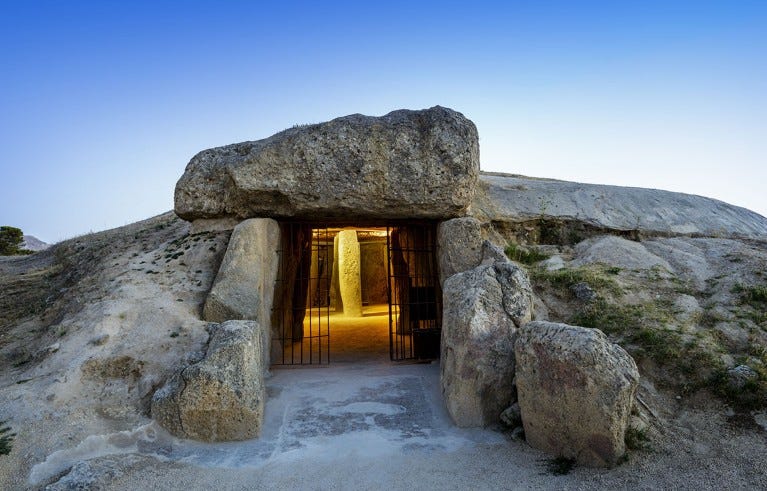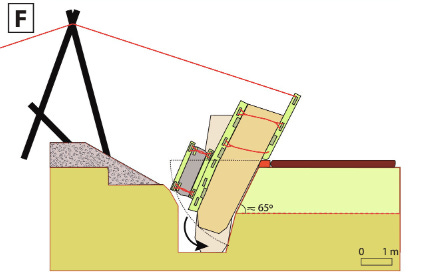Neolithic farmers had 'advanced knowledge' to build earthquake-proof megaliths
There is a missing chunk of history to explain where these farmers obtained their knowledge
A new research article published in Science magazine reveals that ‘Neolithic farmers’ in Southern Spain had ‘advanced knowledge’ of physics, geology, geometry and astronomy almost 6,000 years ago.
The research looked at Menga, a Neolithic dolmen, located in Antequera, Spain. It is estimated to have been built between 3800 to 3600 BC and is the oldest of the great dolmens in Iberia. One of Menga’s capstones weighs an incredible 150 tons, one of the largest in Europe. It was transported from a quarry approximately 1km away.
Not only did these ‘farmers’ have to cut the rock but they then had to transport it, before the invention of the wheel and around 1,000 years before Stonehenge in England was built. The road from the quarry to the Menga site is downhill so the Neolithic people would have needed large ropes as well as an understanding of how to control such a huge mass. The soft nature of the stone means that any unexpected jolt would have damaged the massive stones, meaning a huge amount of time and effort would have been wasted - something you would not have had in Neolithic times.
When the stones had been transported to the correct location they needed ‘early scientific engineering’ skills to design the deep foundation sockets they were placed into. The authors hypothesize that the builders used counterweights to allow ‘millimetric precision’ placement of the stones into the sockets.
Next, our ancient engineers prepared the upright stones with angles between 85°-84°. This made the building narrower in the roof than on the floor, allowing the width of the capstones to be reduced.
The design of the dolmen meant it was incredibly stable. This was a necessity as the area has experienced many major earthquakes but yet it still stands, fully intact, 6000 years later. Stability was achieved through the uprights locking together, creating a solid stone block to hold the capstones, along with pillars for additional support.
Even more incredibly, and one of the reasons the site is still fully intact, is that the builders insulated the inside keeping it perfectly dry. Without this insulation the porous rocks would have suffered major weight changes.
The architects not only chose the correct sized supports but also used an arch-shaped contour for the capstone which helped to distribute vector forces from the centre to the sides.
Advanced knowledge helped the architects and builders use millimetre-scale use of obtuse and straight angles on the facets of the uprights, as well as a precise alignment of its axis to 45°.
Why did Neolithic farmers build these mega-structures? Weren’t they busy just trying to survive? Who organised thousands of men to quarry and lift these huge stones? Where did their knowledge of physics, geometry, geology and architecture come from?
What makes Menga even more incredible is that the researchers can find no precedent suggesting a gradual, steady increase in the development of engineering expertise through trial and error. Instead, it seems to have just popped out of nowhere. “Not only no precedents existed in Iberia for such a monument when Menga was built but also no comparable monument was later made throughout all of Late Prehistory.”
Co-author Leonardo Garcia Sanjuan said “These people had no blueprints to work with, nor, as far as we know, any previous experience at building something like this. And yet, they understood how to fit together huge blocks of stone” with “a precision that would keep the monument intact for nearly 6,000 years”.







The reason it’s still standing is that it wasn’t built to code.
Debbie, you must read the Universal Model (dot) com Volume 1 so that you have a better grounding of young earth geology (YEG) and related timelines. It is not/not creationism as there is no mention of scripture etc. It very clearly and extra-ordinarily lays out the post-flood geological time frame. Once you realize that it is utterly obvious that there was a worldwide flood some 4200 years ago, then not only does the geology and geomorphology you encounter everywhere make sense, but you may finally understand that a small band of humans survived this catastrophic event and brought with them a high level of pre-flood knowledge. Anyone who still believes Darwinism and that we descend from apes is a fool at this point. We only see adaptation within species and never ever a newly evolved species. And not just planet earth but all the data coming in from the universe is that it is all very very young. You will not regret reading the UM- Vol. 1!